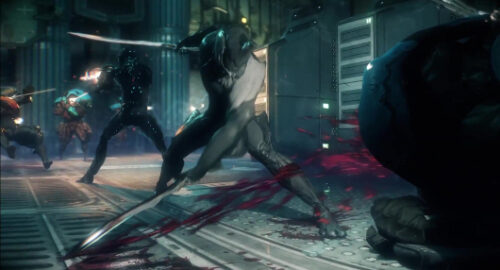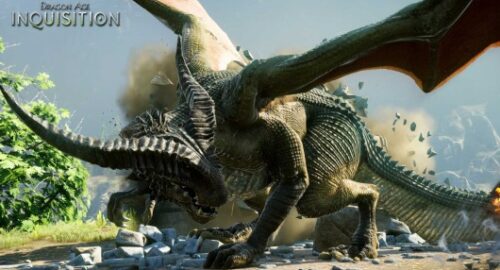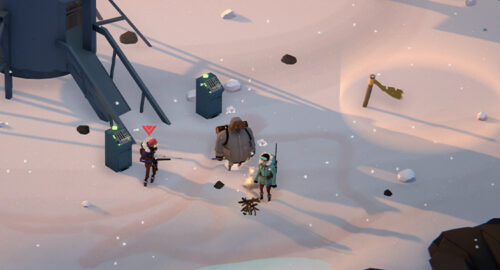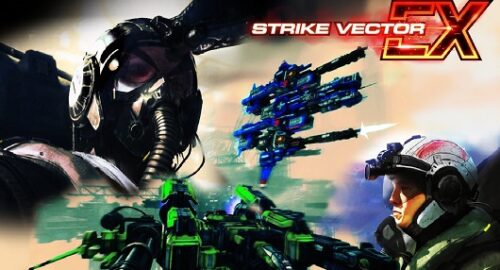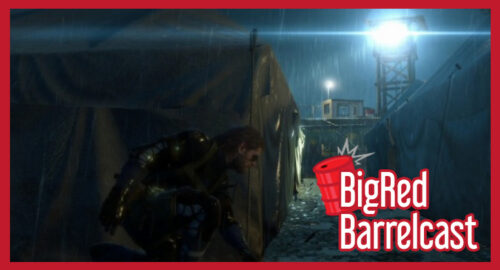I love a good Kickstarter success story, and Anima: Gate of Memories is just that. The follow up to a Wii Ware game you probably never played based on a tabletop role-playing series you’ve probably never heard of, it is the creation of one Carlos B. Garcia, who, along with the help of a ludicrously small team have, for the first time, taken the world of Anima into the realm of 3D with mixed results.
• Developer: Anima Project
• Publisher: BadlandIndie
• Reviewed on: PS4
• Also Available On: Steam, Xbox One
• Release Date: Available Now

The story revolves around two playable characters; The Bearer, a nameless girl with magical powers working for a secret society known as Nathaniel, as somewhat of a demon hunter, and Ergo Mundus, a powerful being (and creepy misogynist) who, centuries ago, was captured and bound to a book, and just so happens to be one of the most annoying and unlikable characters I’ve experienced in a game in recent years.
When the Byblos – an ancient and powerful tome which had been sealed away by the order of Nathaniel – is stolen by one of their own members, the Red Lady, The Bearer and Ergo are sent to chase her down and retrieve the book. However, before they can retrieve the book the Red Lady is cut down by a nameless man, and after a brief fight the two are transported to a mysterious tower known as Arcane.
Within Arcane there are five powerful creatures known as The Messengers who have been summoned there for unknown reasons, and it is the memories of these creatures that shape the areas of this mysterious tower, giving our heroes five unique areas to explore.
Combat and exploration is the name of the game here. To unlock the secrets of Arcane, The Bearer and Ergo must defeat each of the five messengers, and each Messenger can only be accessed when several memories have been recovered from within their area. There is a total of five memories per master, but only three are needed to reach the boss battle, which I was grateful for as a couple of them are tricky to find, and on more than one occasion I wasn’t able to find them until after I’d already defeated the boss and gone back to exploring.
Each memory gives some backstory to The Messenger for that particular area, explaining who they were before they became twisted, and how they came to be that way. I enjoyed taking a couple of minutes out from exploring to listen to the story whenever I found a memory, and the promise of finding out what happened next kept me looking for those hard to find memories. From what I could tell collecting all five memories before the battle doesn’t give you any advantages, but the effort is worth it if you’re a fan of lore building.

Sadly, it’s the combat and exploration mechanics where the game suffers the most.
Being an action-adventure with RPG elements, Gate of Memories has a heavy emphasis on combat, which unfortunately doesn’t work as well as it needs to. It feels sluggish and floaty, and nowhere near as responsive enough to work in a fast paced, style orientated action game in the vein of Devil May Cry like this wants to be.
It’s especially problematic during boss battles where quick reflexes are needed to attack and dodge, but it just isn’t possible here. During a fight with a creature called Nascal The Puppetmaster I found myself flailing endlessly at empty space, only to be knocked into a fire pit again and again. One time after I respawned behind him I was able to stand perfectly still while Nascal himself continued to attack the empty space where I had been previously standing. For ten minutes. It was as funny as it was sad.
There are several platforming sections too that become increasingly tedious. Jumping feels overly ‘floaty’, and neither of the characters cast a shadow underneath themselves when they’re in the air which makes lining up landings more difficult than it should be. I found myself on multiple occasions missing what should have been easy jumps thanks to weird depth perception and no indication of the character model being above the platform I was trying to land on.
Combat is your standard button mashing affair; square is attack, x is jump, and circle, triangle, and L1 perform whichever special attack is mapped to them at the time. R2 is dodge and knockback recovery, and clicking the left analogue stick locks on to an enemy, but this doesn’t work half as well as it should.

As well as a health bar there is also ki, and magic. These are used when performing actions such as attacking or sprinting, or using magic attacks. They regenerate automatically over time, so utilising both effectively is key to stringing together combos. It’s a mechanic we’re all familiar with, and brings nothing new to the table, but it works well enough so I can’t complain.
It’s possible to switch between The Bearer and Ergo using R1, and each character has their own health and energy bars, and special move set up. It’s also possible to set special moves for when you are in mid-air, in a combo, or standing still, giving numerous attack combinations. In theory, this sounds like a deep combat system with countless possibilities, but half the attacks aren’t worth the effort, and I found myself using the same three or four attacks throughout, making an otherwise interesting combat system quite dull.
Levelling up gives you skill points, which are used in the skill tree to upgrade your characters. Each tree has two types of skills, passive and active. Passive skills increase a character’s statistics, and active skills are special attacks or stat buffing spells. Certain skills are locked behind character levels, and others can be upgraded to be made stronger, but I didn’t notice much difference in power whenever I upgraded anything.
Stat increases are available through skill lines. Each skill on the tree is connected via skill lines, and unlocking the skills on either end of the skill line unlock a stat increase, but again, I really didn’t notice much difference.
Inconsistent difficulty was one of my major issues with Gate of Memories. The balance is completely unfair. I found myself bumbling through the main levels with relative ease, only to find myself hitting a wall when I came up against a boss. It’s not even as if the bosses are difficult from a skill point of view, they’re just suffer from what one of my friends calls “SNK boss syndrome”. In short, they’re cheap and nasty.

One boss battle in particular had me screaming creative curses at the TV. It would just pin me down with spammed projectile attacks and instant cast spells that inverted the controls and flipped the screen. I finally defeated it by backtracking to an area with high enemy spawns, and accidentally finding a bug that caused them to spawn infinitely, allowing me to jump up five levels and max out my skill tree in little over an hour, unlocking a projectile energy attack that homes in on all enemies in the area and spamming the boss with it until dead.
It had ripped away any feeling of skill or accomplishment from the battle, and I didn’t even feel bad using such cheap tactics. I was playing by the game’s rules, and when one of those rules is ‘use exploits to win’ you are not playing a balanced game.
By far my biggest issue with the game, however, is Ergo Mundus. He is without a doubt one of the worst characters I have ever had to suffer through in almost 30 years of gaming. He’s a complete creep, cracking jokes about molesting The Bearer in her sleep, and constantly calling her ‘baby’ in such a way that made me shudder in disgust. Slime oozes off every word he says and it is unbearable at times.
His dialogue is absolutely awful too. When running around Arcane he’ll often fill the silence with bad puns and juvenile innuendo that is just painful to listen to, for example; “You know what the best part of this adventure has been? Banging against your ass for hours.” Nothing says ‘we aren’t funny’ like badly written misogyny.
The character is so bad that when his story arc was finally resolved (in any of the multiple endings I experienced) I just didn’t care. When the only emotion you feel after a story’s conclusion is relief that you don’t have to deal with the character anymore something is seriously wrong.

The text is littered with grammatical errors, and the onscreen text and subtitles more than occasionally display something completely different to what the voice actors are saying, but I can’t come down too hard on it for that seeing as the localisation ‘team’ was only two people. Although with the amount of outdated pop culture references littered throughout the poorly written dialogue I’d be tempted to believe these errors were there on purposes.
The game is at its strongest during the puzzle and exploration sections. They’re simple in design and concept, but engage you in a way many modern games do not. For example, in one area I had to find names to use on combination locks, and these names were hidden within the memories I found in the area, meaning I had to actually pay attention to what I was being told. It sounds simple, but in a world where every puzzle solution and piece of information is laid out for you on a HUD it was nice to discover these things myself.
One area in particular called The Shrine of Seasons stands out as a strong point to me. Even though the puzzles were simple switch hitting in nature, the area was a nice change of pace from the boring combat. And when enemies did attack, the fights were few and far between.
When Anima: Gate of Memories works, I enjoyed my time with it, and despite my many, many complaints with the mechanics, something more than a review obligation kept me going back. I like the aesthetic of the cell shaded characters on top of the gothic architecture of Arcane, and the various wings and focus on combat make Gate of Memories feel more like a 3D Castlevania than the titles developed by Mercury Steam a few years ago.
The way the different wings have been designed around the boss for that area, on top of having their history drip fed to you through the discovery of memories gives each area a unique feel, making the time spent in each wing feel like its own isolated story. The designs for the main characters and bosses are great too, although The Bearers unnatural breast movement when she’s standing still is hilariously bad.
It feels like the developers were overreaching with this one, and that’s not a bad thing per se. I appreciate what the guys at Anima Project set out to do, and am even impressed with what such a small team managed to achieve, especially through Kickstarter, and it’s the fact that they are such a small team that I’m not giving Anima: Gate of Memories a lower score. However, it doesn’t change the fact certain elements that need to work in a game like this just don’t. It’s a shame, because with a bit more focus or a lot more polish Anima: Gate of Memories could have been great instead of just ok.

